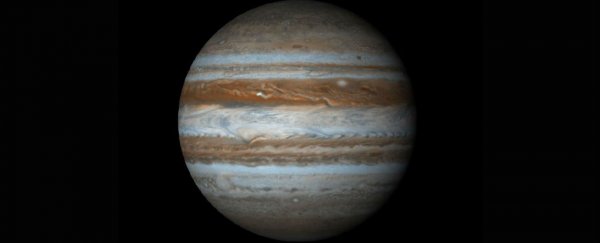In another time, before Earth, our early Solar System might have boasted giant terrestrial planets inside the orbit of present-day Mercury.
And then, Jupiter came through like a wrecking ball of mass-destruction. As it moved toward the Sun, its gravitational force triggered a domino-effect of collisions, which ultimately destroyed these early planets and paved the way for the likes of Mercury, Venus, Earth and Mars to eventually form.
And then Jupiter - our new hero - coolly retreated back to the far-flung orbit it occupies today, thanks to some gravitational assistance from its pal Saturn.
It may sound far-fetched, but the theory - which has been described and modelled by a pair of astrophysicists in the US - could help explain why our outlier Solar System is so different from the hundreds of other planetary systems discovered in recent years, which tend to have an abundance of super-Earths on a tight orbital path of less than 100 days around their host star.
"Now that we can look at our own Solar System in the context of all these other planetary systems, one of the most interesting features is the absence of planets inside the orbit of Mercury," said astrophysicist Gregory Laughlin from the University of California Santa Cruz in a press release.
"The standard issue planetary system in our galaxy seems to be a set of super-Earths with alarmingly short orbital periods," he said. "Our Solar System is looking increasingly like an oddball."
Laughlin and his former student, Konstantin Batygin, who now teaches at the California Institute of Technology, wanted to understand why our Solar System was such an anomaly.
As the premise for their research, they used something known as the Grand Tack scenario, which suggests that Jupiter made an inward migration toward the Sun during its formation, before being drawn back into its current orbit by the gravitational pull of an evolving Saturn.
Working under the assumption that our Sun was once surrounded by super-Earths at very near proximity, the researchers developed a model to test the impact that a wayward Jupiter would have had on this first-generation of rocky planets.
As it made its inward journey, they have shown that Jupiter would have caused severe gravitational disturbances, causing these inner planets - along with evolving planets and asteroids - to shift into dangerously overlapping orbits. Eventually, this disturbance would have resulted in a series of collisions that spelled their doom.
"It's the same thing we worry about if satellites were to be destroyed in low-Earth orbit. Their fragments would start smashing into other satellites and you'd risk a chain reaction of collisions. Our work indicates that Jupiter would have created just such a collisional cascade in the inner Solar System," Laughlin said in the press release.
Luckily, we humans are the benefactors in this awesome theory of planetary demolition.
While much of the debris would have spiralled into the Sun, the small amount that remained eventually - over hundreds of millions of years - coalesced into the rocky planets we now know and love, including Earth.
This is consistent with evidence that our Solar System's present-day inner planets are younger than it's outer planets. It also "explains why the Solar System's inner planets are so small and contain such thin atmospheres, compared to those seen in other planetary systems," Batygin told Stuart Gary from ABC Science.
The team's study has been published in the Proceedings of the National Academy of Sciences.
Anders Johansen, a senior lecturer at the Lund Observatory in Sweden, who did not take part in the study, told CBS News that the study is "interesting because it highlights that the Solar System could have harboured one or several super-Earths that migrated into the Sun following Jupiter's inwards migration."
But he reiterated that it was a theory and told CBS News "the authors do not show that this actually did happen in our Solar System."
Sources: ABC Science, CBS News
